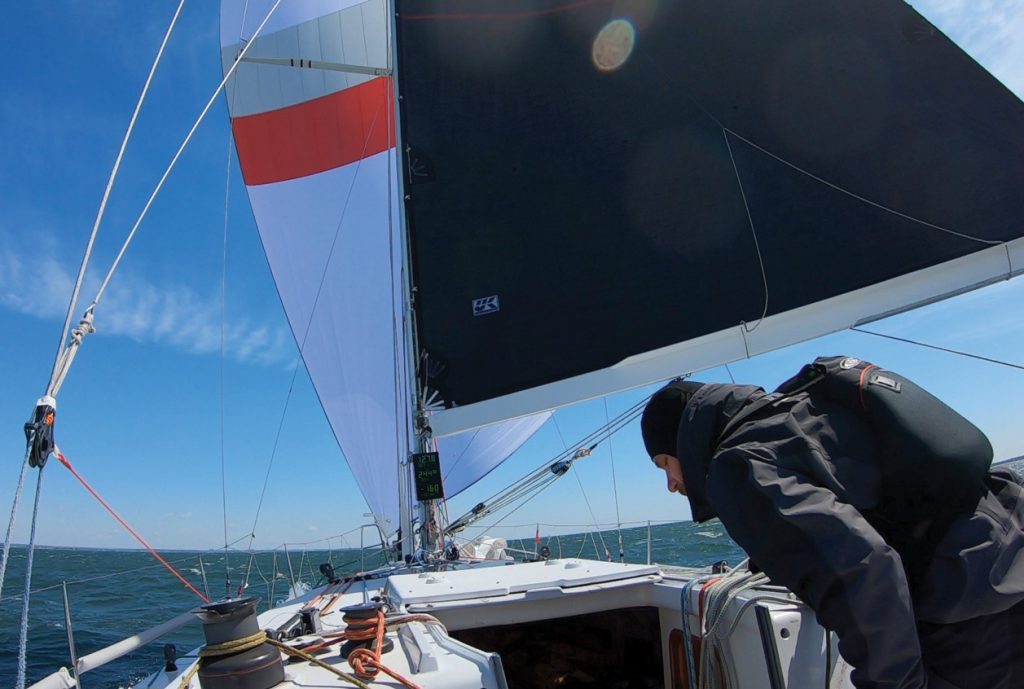
Gerard Girstl prepares to jibe during a breezy race for doublehanded boats last May. © Adam Loory
Of course, my first doublehanded race of 2020 had to be sailed in 18-26 knots – trial by fire. It was a 20-mile race where the course was a 10-mile dead run followed by a 10-mile square beat. My 40-footer is usually raced by a crew of 10 or 11 people, but to respect the need for social distancing and in the absence of any other racing on the calendar, I created a five-weekend series of doublehanded races on New York’s Long Island Sound. There was no entry fee, no committee boat, no trophies, and no party. The idea was to simply get out on the water and have some competitive fun in a virus-safe environment. A pursuit format was used for two reasons. First, there is less need for a committee boat since the order of finish is the results. Second, only one or two boats are on the starting line at the same time – which is helpful for shorthanded teams sailing boats not optimized for doublehanded racing.
Right off the starting line, my doublehanded partner Gerard Girstl and I saw a massive puff coming and had to decide whether to wait for it to pass or try to get the chute up before it hit. We got the massive 180 square meter chute up and drawing before the puff hit and the boat accelerated to 11 knots and higher.
Gerard told me to avoid sailing higher and faster, because that could result in heeling too much with the risk rolling out. He said it was better to sail deeper angles since we would lose less time from having the chute collapse behind the main than from having to recover from a rollout.
As a result of getting lifted, our first big test came from having to gybe. We waited for a lull, when the wind calmed down below 20 knots. The sail plan on my boat Soulmates is massive and the fractional four-spreader rig is held up by running backstays, which adds a bit of drama to the jibes.
In winds over 10 knots, we do outside jibes since we don’t have a lot of hands to pull the asymmetrical chute around. The trick is to grind the main in most of the way first and tighten the leeward runner as much as possible. Having it on a self-tailing winch allows me to use one hand to grind runner on, which then pulls the boom close to centerline. With the main in, the spin sheet is blown off the winch so that the clew blows forward of the forestay. Now it is time to turn the boat, release the old runner, ease the main out, and only then trim in the chute. Because keeping the mast up is the most important part of the gybe, the spinnaker is left luffing in front of the boat while we get the runners and the mainsail squared away. Before letting the sheet run, make sure you have stopper knots in the ends of the sheets. I use slipknots for those “just in case” situations.
When it came time for our final jibe to the turning mark, we chose to douse the spinnaker first since the wind was holding in the mid-20s by then. We started our letterbox takedown 1.5 miles from the mark. With the chute down and stuffed below, we did a chicken jibe (270-degree tack) to give more time to get the running backstays set and to avoid have the boom slam across the boat. Then we raised the J4 and jib-reached to the turning mark. The maneuvers were slow, controlled and safe.
In the pursuit format, the slowest boat in the fleet starts first and all the other boats start later based on how much time they owe the slowest boat for the course. The last boat to start is the fastest. If all works as the handicappers planned, everyone should finish at the same time. In this race, the rating committee earned their stripes. The finishes of the top four boats were extremely close. Soulmates, the last boat to start, finished first – 20 seconds ahead of the two boats that tied for second place, the J/88 One Too Many and the New York 36 Turning Point. The Frers 33 Southern Cross finished fourth, two minutes behind the tied boats.
Even though Turning Point broke her spinnaker pole in a jibe broach, her skipper Rich Gold couldn’t have been happier. After the third race of the doublehanded social distance racing series he wrote, “I thank you for providing a spring worth remembering amidst a year of Covid-19, which we want to forget. Racing doublehanded requires a lot of dynamic skills to enable skipper and crew to have fun safely. I enjoyed trying to pull it off with my New York 36, a 42-year-old IOR design. Congratulations to the winners, crews and to the entire bunch of sailing enthusiasts that defined their May in a sailor’s way.” ■
Adam Loory is the General Manager of UK Sailmakers International in Port Chester, NY.
Our friends at UK Sailmakers have embraced the doublehanded racing trend with gusto, developing a range of sail products to support the unique needs of shorthanded sailors and serving in an advisory role to help sailors adapt to what for many is a new paradigm in sailing.
This article originally appeared on the new “Doublehanded Racing Tips” section of their website, which can be found at uksailmakers.com/doublehanded-racing-tips.



